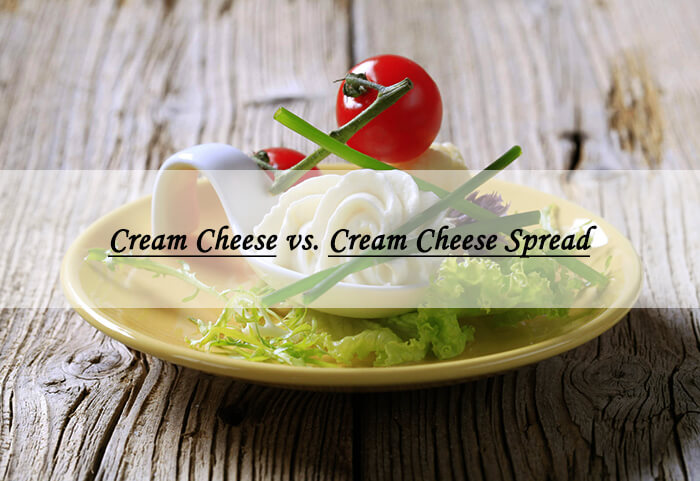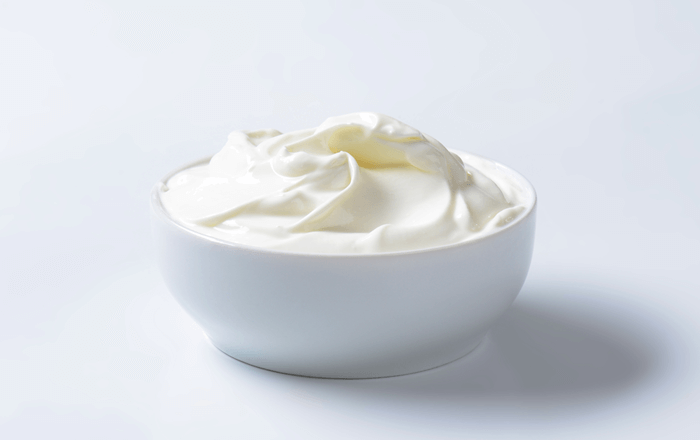Dairy consumption is not going anywhere soon, it seems. According to the International Dairy Foods Association, dairy consumption hit almost 660lbs per capita in the United States in 2020.
As more folks turn to dairy for their cooking and baking needs, more people want to know if cream cheese spread is the same as cream cheese.
To answer this question, we must break down the attributes of both popular kitchen staples.
Table Of Contents
15-Second Summary
For a quick overview of how cream cheese and cream cheese spreads are different, take a look at these highlights:
- Cream cheese spread is essentially whipped cream cheese with some extra ingredients.
- Cream cheese is a fresh cheese used in desserts and some meal recipes, while cream cheese spread is a condiment or topping.
- Cream cheese tastes slightly sweet, while cream cheese spreads typically have a savory flavor.
Facts About Cream Cheese You Should Know
What Is Cream Cheese
Cream cheese [1] is a cheese made using milk and various creams to create a soft, mild-tasting product.
Flavor & Taste
This cheese is white in color and has a semisweet flavor and fluffy texture.
Uses
The most common use for cream cheese is in desserts.
Frostings tend to call for cream cheese thanks to its sweet taste and the ability of cream cheese to hold up well when refrigerated.
Cream cheese also pairs well with the flavors in many desserts like cakes, cupcakes, and cheesecakes.
Cream cheese can substitute butter or oil in several recipes, acting as a common alternative to butter in frosting, mashed potatoes, or as a base for dips.
Other Facts
The most common form you’ll find cream cheese in is a sealed brick.
Commerical cream cheeses add stabilizers and preservatives to the cheese to help the cheese keep its flavor and structure.
Homemade cream cheese made using milk, cream, and lemon or vinegar must be used the same day, or else the cheese loses its freshness.
Facts About Cream Cheese Spread You Should Know
What Is Cream Cheese Spread
Cream cheese spread [2] refers to a spreadable condiment made using cream cheese as the base.
Flavor & Taste
The cream cheese spread can come in different flavors but most often tends to have a saltier or savory flavor than standard cream cheese.
This spread gets its smooth consistency from the other ingredients added and the extra whipping done during production.
Whipping cream cheese adds more air into the mixture, smoothing out the otherwise crumbly cheese into an even consistency.
Uses
As a condiment, cream cheese spread acts as a complement to a finished dish. Bagels, sandwiches, and vegetables are common foods paired with a cream cheese spread.
You won’t see cream cheese spreads called for in desserts due to the savory flavors folks tend to prefer in cream cheese spreads. These flavors conflict with the sweetness of most desserts.
Cream Cheese vs. Cream Cheese Spread
With the definitions laid out for cream cheese and cream cheese spread, let’s dive into how these two food items differ:
Differences | Cream Cheese | Cream Cheese Spread |
Ingredients | Milk and various creams | Cream cheese and other ingredients |
Taste | Semisweet | Depends on the ingredients |
Nutritional Content | More calories, cholesterol and fats | More salt and artificial ingredients |
Shelf Life | Short | Long |
Purpose | Frosting | Spread and dip |
Uses | Desserts | Used as a complement to a finished dish |
Ease of Use
A premade cream cheese spread will be easier to use than a block of cream cheese.
Cream Cheese Spread
Cream cheese spreads need whipping to fluff up and are flavored to compliment the bread and vegetables served.
For most folks, using a cream cheese spread is as easy as opening the container and adding as much as they like.
Cream Cheese
Cream cheese needs work to be added to a dish. It doesn’t carry the added flavors from the spread and crumbles instead of spreading when you apply pressure to it.
Flavor
Cream cheese and its spreadable cousin tend to have very different flavors.
Cream Cheese
Cream cheese has a semisweet flavor due to the milk and creams that add lightness. Both added ingredients have sugars that come out somewhat when making cream cheese.
Cream Cheese Spread
Cream cheese spreads, however, tend to have savory flavors infused into them.
Green onion, chive, and herb blends are the most common flavors added into a cream cheese spread you find available in a store.
Nutritional Content
Due to the addition of extra ingredients during manufacturing, the nutritional content of cream cheese and cream cheese spread items can be very different.
In general, a cream cheese spread tends to have fewer calories than an equal amount of regular cream cheese due to the increased air in the cream cheese spread.
Cream cheese spread also tends to have less cholesterol and fats than cream cheese.
However, most premade cream cheese spreads have more salt and other artificial ingredients.
Shelf Life
Even with added stabilizers and preservatives, cream cheese won’t last as long in your fridge as a cream cheese spread.
The added air helps keep the cream cheese spread fresher for longer than a block of cream cheese.
The Best Cream Cheese and Cream Cheese Spread Review
To help you find cream cheeses worthy of your kitchen, we have a couple of quick reviews for you to take a look at:
Best Cream Cheese: 365 Rbst-Free Cream Cheese
For a simple block of cream cheese, it’s hard to pass up 365’s Rbst-Free Cream Cheese.
This eight-ounce block of cream cheese contains milk from cows not treated with rBST, a recombinant growth hormone used to accelerate the growth of cows on farms.
365 excludes this hormone from their cream cheese to satisfy the needs of cooks who wish to keep their ingredients hormone-free.
The flavor is slightly sweet, and the product contains six ingredients, with half acting as natural stabilizers or preservatives.
Best Cream Cheese Spread: Organic Valley Cream Cheese Spread
Keeping on the healthy trend, Organic Valley’s Cream Cheese Spread follows many of the same guidelines 365 does for their cream cheese.
Organic Valley uses milk from cows untreated with hormones or antibiotics to ensure those don’t end up in your cheese spread.
While Organic Valley is pricier than many other cream cheese spreads, the company goes out of its way to ensure its quality.
Final Words
In the cream cheese vs. cream cheese discussion, please remember that they have different tastes and culinary purposes and are not the same.
Cream cheese gets combined with other ingredients to create a cream cheese spread.
The resulting product tends to be on the savory side, which is different than the naturally sweet flavor of a regular block of cream cheese.
While you can find unflavored cream cheese spreads, the most common ones clash with the usual desserts and dishes that call for regular cream cheese.
So, ensure that the next time you read through a recipe, you grab the correct cream cheese for the job!




